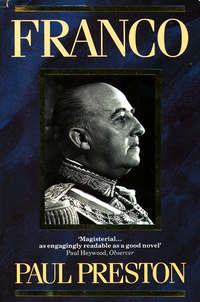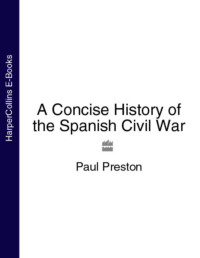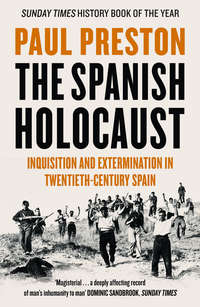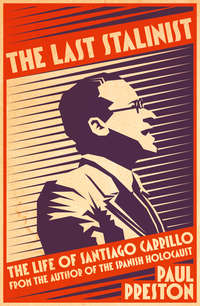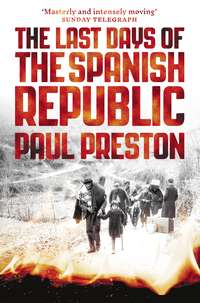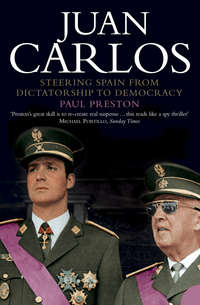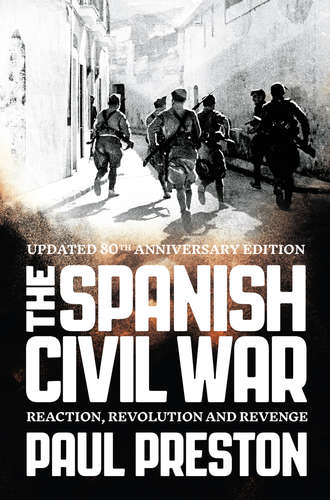
Полная версия
The Spanish Civil War: Reaction, Revolution and Revenge
The left was very aware of such developments and was determined to avoid the fate of the German and Austrian left. As 1934 progressed there were growing numbers of street battles between left and right. Events within the orthodox political arena did little to cool tempers. Lerroux resigned in April after Alcalá Zamora had hesitated about signing an amnesty bill which reinstated the officers involved in the Sanjurjo rising of 1932. Socialists and Republicans alike felt that the government was signalling to the army that it could make a coup whenever it disliked the political situation. The left was already suspicious of the government’s reliance on CEDA votes, since Gil Robles continued to refuse to swear his loyalty to the Republic. Moreover, since he made it quite clear that when he gained power he would change the Constitution, the left was coming to believe that strong action was necessary to prevent him doing so. In fact, even if Gil Robles was not quite as extreme as the left believed him to be, he managed to convey the impression that the Radical government, backed with CEDA votes, was intent on dismantling the progressive, reforming Republic that had been created in 1931.
In this context, it was difficult for the Socialist leadership to hold back its followers. Largo Caballero tended to give way to the revolutionary impatience of the masses, although his rhetoric, which they cheered to the echo, was unspecific and consisted largely of Marxist platitudes. No concrete relation to the contemporary political scene was ever made in Largo Caballero’s speeches of early 1934 and no timetable for the future revolution was ever given. However, rank-and-file pressure for the radicalization of the Socialist movement, particularly from its youth movement, the Federatión de Juventudes Socialistas (FJS), and its Madrid organization, the Agrupación Socialista Madrileña, developed throughout 1934. This led to important divisions within the PSOE. The right-wing of the party, led by the professor of logic Julián Besteiro, tried several tactics to slow down the process of bolshevization which was taking place within the party. This merely earned Besteiro the vehement hostility of the radical youth. The centre, led by the ever-pragmatic Indalecio Prieto, reluctantly went along with the revolutionary tactic out of party loyalty. The young followers of Largo Caballero came to dominate the party and the UGT, with the organizations of the Socialist movement falling into their hands in quick succession.
Thus, political tension grew throughout 1934. In March, the anarchists held a four-week strike in Zaragoza to protest against the maltreatment of prisoners taken after the December rising. Then the CEDA made a sinister gesture in the form of a large rally of its youth movement, the JAP. The choice of Philip II’s monastery of El Escorial as venue was an unmistakably anti-Republican gesture. In driving sleet, a crowd of twenty thousand met in a gathering which closely resembled a Nazi rally. They swore loyalty to Gil Robles, ‘our supreme chief’, and chanted ‘¡Jefe! ¡Jefe! ¡Jefe!’. The JAP’s nineteen-point programme was recited, with emphasis on point two, ‘our leaders never make mistakes’, a direct borrowing from the Italian Fascists. One CEDA deputy declared that ‘Spain has to be defended against Jews, heretics, freemasons, liberals and Marxists’. Another, the deputy for Zaragoza, Ramón Serrano Suñer, brother-in-law of General Franco and later architect of the post-Civil War National-Syndicalist state, denounced ‘degenerate democracy’. The high point of the rally was a speech by Gil Robles. His aggressive harangue was greeted by delirious applause and prolonged chanting of ‘¡Jefe!’. ‘We are an army of citizens ready to give our lives for God and for Spain,’ he cried. ‘Power will soon be ours … No one can stop us imposing our ideas on the government of Spain’.
The young revolutionaries of the FJS were convinced that Gil Robles was aiming to take over the government in order to bring the Republic to an end. Various Radical ministries were incapable of allaying the suspicion that they were merely Gil Robles’ Trojan Horse. By repeatedly threatening to withdraw his support, Gil Robles provoked a series of cabinet crises by complaining that the cabinet was too liberal. As a result, the Radical government was adopting an ever-more conservative veneer. On each occasion, Lerroux, who was desperate to stay in power, would force the more liberal elements of his party out of the cabinet. Accompanied by like-minded friends, they then quit the party, leaving the rump ever more dependent on CEDA whims. After the first of the reshuffles, in March 1934, Gil Robles found a Radical minister who enjoyed his unalloyed trust. This was Rafael Salazar Alonso, the Minister of the Interior and a representative of the aggressive landowners of Badajoz. One of his first acts as minister was to call in the Inspector General of the Civil Guard, Brigadier General Cecilio Bedia de la Cavallería, and make it clear that his forces should not be inhibited in their repression of social conflicts. Although Lerroux resisted the temptation to declare all strikes unlawful, he delighted the right by announcing that strikes with political implications would be ruthlessly suppressed. For both the CEDA and Salazar Alonso, all strikes were deemed to be political. He provoked a number of strikes throughout the spring and summer of 1934 which enabled him to pick off the most powerful unions one by one, beginning with the printers in March. The Radical–CEDA determination to undermine the Republic’s most loyal support became clear when the government clashed successively with the Catalans and the Basques.
The sympathy shown by the Constituent Cortes to autonomist aspirations was now dropped in favour of right-wing centralist bias. This was particularly the case with regard to Catalonia. Unlike the rest of Spain, Catalonia was governed by a truly Republican party, the Esquerra, under Lluis Companys. In April, Companys passed an agrarian reform, the Ley de contratos de cultivo, an enlightened measure to protect tenants from eviction by landowners and the right to buy land which they had worked for eighteen years. The law was opposed by the landowners and the Catalan conservative party, the Lliga, protested to the Madrid government with the backing of the CEDA. The right of the central government to intervene in Catalonia over this issue was not clear. Under pressure from the CEDA, the Radical cabinet handed the question to the Tribunal of Constitutional Guarantees, whose membership was predominantly right wing. On 8 June, by a small majority, the Tribunal found against the Generalitat. Nevertheless, Companys went ahead and ratified the law. Meanwhile, the government began to infringe the Basques’ tax privileges and, in an attempt to silence protest, forbade their municipal elections. Such high-handed centralism could only confirm the left’s fears of the Republic’s rapid drift to the right.
Trouble increased during the summer. Rural labourers were suffering immense hardship through increased aggression from employers, which had been greatly facilitated by the repeal in May of the law of municipal boundaries. Coming just before the harvest, this permitted landlords to import cheap Portuguese and Galician migrant workers to undercut local wages. The defences of the rural proletariat were falling rapidly before the right-wing onslaught. The last vestige of protection that left-wing landless labourers had for their jobs and their wages was that provided by the Socialist majorities on many town and village councils. Socialist mayors were the only hope that rural workers had of the local landowners being obliged to observe social legislation or of municipal funds being used for public works that would provide some employment. The Radicals had been systematically removing them, Salazar Alonso using flimsy pretexts such as ‘administrative irregularities’. He ordered provincial civil governors to remove alcaldes who ‘did not inspire confidence in matters of public order’ – which usually meant Socialists.
After much agonized debate within the FNTT, Ricardo Zabalza began to advocate a general strike in order to put a stop to the patronal offensive. Older heads within the UGT were opposed to what they saw as a rash initiative which might squander worker militancy and thus undermine the possibility of a future defence against attempts to establish a reactionary corporative state. The harvest was ready at different times in each area, so the selection of a single date for the strike would lead to problems of coordination. Moreover, a general strike, as opposed to one limited to large estates, would cause hardship to leaseholders and sharecroppers who needed to hire one or two workers. There was also the danger that the provocative actions of the owners and the Civil Guard could push the peasants into violent confrontations which they could only lose. Nevertheless, under extreme pressure from a hungry rank and file pushed beyond endurance by the constant provocation of caciques and Civil Guard, the FNTT called for a series of strikes, to be carried through in strict accordance with the law.
While the strike action could hardly be considered revolutionary, Salazar Alonso was not prepared to lose this chance to strike a blow at the largest section of the UGT. His measures were swift and ruthless. Within weeks of taking over the Ministry of the Interior, in meetings with the head of the Civil Guard General Bedia de la Cavallería and the Director General de Seguridad José Valdivia, he had already made specific plans for the repression of such a strike. Accordingly, just as Zabalza’s hopes of compromise negotiations between the FNTT and the Ministers of Agriculture and Labour were about to be fulfilled, Salazar Alonso issued a decree criminalizing the actions of the FNTT by declaring the harvest a national public service and the strike a ‘revolutionary conflict’. Liberal and left-wing individuals in the country districts were arrested wholesale, including four Socialist deputies. This was a flagrant violation of Articles 55 and 56 of the Constitution. Several thousand peasants were loaded at gunpoint onto lorries and deported hundreds of miles from their homes and then left without food or money to make their own way back. Workers’ centres were closed down and many town councils were removed, to be replaced by government nominees. Although most of the labourers arrested were soon released, emergency courts sentenced prominent workers’ leaders to four or more years in prison. The workers’ societies in each village, the Casas del Pueblo, were closed and the FNTT was effectively crippled until 1936. In an uneven battle, the FNTT had suffered a terrible defeat. Salazar Alonso had effectively put the clock back in the Spanish countryside to the 1920s.
The politics of reprisal were beginning to generate an atmosphere, if not of imminent civil war, certainly of great belligerence. The left saw fascism in every action of the right; the right smelt revolution in every left-wing move. Violent speeches were made in the Cortes and, at one point, guns flourished. In the streets shots were exchanged between Socialist and Falangist youths. Juan Antonio Ansaldo, a well-known monarchist playboy and aviator, had joined the Falange in the spring to organize terrorist squads. A plan to blow up the Madrid Casa del Pueblo was thwarted when the police discovered a large cache of arms and explosives. The actions of the Falangist hit squads provoked reprisals by the would-be revolutionaries of the Federatión de Juventudes Socialistas. The government’s attacks on regional autonomy and the increasingly threatening attitude of the CEDA were driving the Socialists to play with the idea of a revolutionary rising to forestall the destruction of the Republic.
The JAP held another rally, on 9 September, this time at Covadonga in Asturias, the starting point for the reconquest of Spain from the Moors. This was clearly a symbol of warlike aggression which foreshadowed the Francoist use after 1936 of the violent crusade imagery of the Reconquista. Gil Robles spoke in violent terms of the need to annihilate the ‘separatist rebellion’ of the Catalans and the Basque Nationalists. Revelling in the adulation of the assembled ranks of the JAP, the supreme Jefe worked himself up to a frenzy of patriotic rhetoric calling for nationalism to be exalted ‘with ecstasy, with paroxysms, with anything; I prefer a nation of lunatics to a nation of wretches’. Behind his apparently spontaneous passion was a cold-blooded determination to provoke the left. Gil Robles knew full well that the left considered him a Fascist. He was also aware that it intended to prevent the CEDA coming to power, although he was confident that the left was not in a position to succeed in a revolutionary attempt.
The preparations for revolution by the young Socialists had consisted largely of Sunday picnics in Madrid’s Casa del Campo during which military manoeuvres, without weapons, were amateurishly practised. Salazar Alonso had had no difficulty in tracking down the few revolvers and rifles that had been acquired by means of expensive encounters with unscrupulous arms dealers. Thanks to informers in the PSOE or to the arms dealers themselves, when the police subsequently raided the houses of militants and on Casas del Pueblo they seemed to know exactly where guns were concealed behind partitions or under floorboards. The most notorious arms purchase was carried out by Prieto, when arms – initially ordered by exiled enemies of the Portuguese dictatorship who could not pay for them – were shipped to Asturias on the steamer Turquesa. In a bizarre incident, the shipment fell largely into the hands of the police although Prieto escaped. Only in Asturias was the local working class even minimally armed, as a result of pilfering from local small-arms factories and dynamite available in the mines.
On 26 September the CEDA opened the crisis by announcing that it could no longer support a minority government. Lerroux’s new cabinet, announced late at night on 3 October, included three CEDA ministers. To the left, it seemed as if this was the first step towards the imposition of fascism in Spain. The reaction of the Republican forces was abrupt. Azaña and other leading Republicans denounced the move and even the conservative Miguel Maura broke off relations with the President. The Socialists were paralysed with doubt. They had hoped that threats of revolution would suffice to make Alcalá Zamora call new elections. Now, the UGT gave the government twenty-four hours’ notice of a pacific general strike. The Socialists hoped that the President would change his mind but they merely succeeded in giving the police time to arrest working-class leaders. In most parts of Spain, the strike was a failure largely because of the prompt action of the government in declaring martial law and bringing in the army to run essential services.
In Barcelona, events were more dramatic. In an attempt to outflank extreme Catalan nationalists, and seriously alarmed by developments in Madrid, Companys proclaimed an independent state of Catalonia ‘within the Federal Republic of Spain’. It was a protest against what was perceived as the Fascist betrayal of the Republic. The CNT stood aside since it regarded the Esquerra as a purely bourgeois affair. In fact, the rebellion of the Generalitat was doomed when Companys refused requests to arm the workers. Bloodshed was avoided by his moderation, which was matched by that of General Domingo Batet, the officer in command of the Catalan military region (or Fourth Organic Division, as it was called). General Batet employed common sense and restraint in restoring the authority of the central government. He ordered his men to be ‘deaf, dumb and blind’ before any provocations. In so preventing a potential blood bath, he incurred the wrath of General Francisco Franco, who was directing the repression from Madrid. Franco had sent warships to bombard the city and troops of the Foreign Legion. Batet ignored Franco’s recommendation to use the Foreign Legion to impose savage punishment on the Catalans and thus kept casualties to a minimum. In avoiding the exemplary violence that Franco regarded as essential, however, Batet was paving the way to his own execution by the Francoists during the Spanish Civil War.
The only place where the protests of the left in October 1934 were not easily brushed aside was in Asturias. There, spontaneous rank-and-file militancy impelled the local PSOE leaders to go along with a revolutionary movement organized jointly by the UGT, the CNT and, belatedly, the Communists, united in the Alianza Obrera (Workers’ Alliance). The local Socialist leaders of the mineworkers knew that the strike was doomed without support from the rest of Spain but they opted to stay with their men. The Minister of War, the Radical Diego Hidalgo, had given Franco informal control of operations. He made him his ‘adviser’ and used him as an unofficial Chief of the General Staff, by dint of marginalizing his own staff and dutifully signing the orders drawn up by Franco. The Minister’s decision was entirely comprehensible. Franco had detailed knowledge of Asturias, its geography, communications and military organization. He had been stationed there, had taken part in the suppression of the general strike of 1917 and had been a regular visitor since his marriage to an Asturian woman, Carmen Polo. What delighted the Spanish right was that Franco responded to the rebellious miners in Asturias as if he were dealing with the recalcitrant tribes of Morocco.
To this end, Franco brought in the hardened mercenaries of Spain’s colonial Army of Africa. Uninhibited by the humanitarian considerations which made other more liberal officers hesitate to use the full weight of the armed forces against civilians, Franco regarded the problem before him with the same icy ruthlessness that had underpinned his successes in the colonial wars. The miners organized a revolutionary commune with transport, communications, hospital facilities and food distribution, but had few weapons. Armed largely with dynamite, they were reduced to submission by both heavy artillery attacks and bombing raids. The Spanish Foreign Legion committed atrocities, many women and children were killed and, when the principal Asturian cities, Gijón and Oviedo, fell, the army carried out summary executions of leftists. Franco commented casually to a journalist, ‘The war in Morocco, with the Regulares and the Legion, had a certain romantic air, an air of reconquest. But this war is a frontier war and its fronts are socialism, communism and whatever attacks civilization in order to replace it with barbarism.’
The Asturian rising demonstrated to the left that it could carry out change only by legal means. It also demonstrated to the right that its best chance of preventing change lay with the instruments of violence provided by the armed forces. In that sense, it marked the end for the Republic. To Gerald Brenan, the great British writer on Spain who lived in Málaga at the time, it was ‘the first battle of the Civil War’. The conflict did not end with the defeat of the miners. As their leader, Belarmino Tomás, put it, ‘our surrender today is simply a halt on the road, where we make good our mistakes, preparing for the next battle’. There could be no going back. The October revolution had terrified the middle and upper classes; and in their terror they took a revenge which determined the left that they must reunite in order to win power electorally. The Socialist movement was, in fact, badly scarred by the events of October 1934. The repression unleashed in the aftermath of the October rising was truly brutal. In Asturias, prisoners were tortured. Thousands of workers were imprisoned. Virtually the entire UGT executive was in jail. The Socialist press was silenced.
Nothing was done in the next fifteen months to reconcile the hostilities aroused by the revolution and its repression. Despite the CEDA’s much-vaunted aim of beating the revolution by a programme of social reform, proposals for moderate land reform and for tax reforms were defeated by right-wing intransigence. Indeed, Manuel Giménez Fernández, the CEDA Minister of Agriculture, encountered embittered opposition within his own party to his mildly reformist plans. He was denounced as the ‘white Bolshevik’. There was room only for the punishment of the October rebels. Gil Robles demanded the ‘inflexible application of the law’. Companys was sentenced to thirty years imprisonment. The thousands of political prisoners remained in jail. A vicious campaign was waged against Azaña in an unsuccessful attempt to prove him guilty of preparing the Catalan revolution. The Catalan autonomy statute was suspended.
Then, when the CEDA failed to secure the death penalty for two Asturian Socialist leaders, its three ministers resigned. Gil Robles thus resumed his tactic of provoking cabinet crises in order to weaken the Radicals. He hoped to move crab-like towards taking power himself. He was rewarded in early May when Lerroux’s new government contained five Cedistas, including Gil Robles himself as Minister of War. It was a period of open reaction. Landlords halved wages and order was forcibly restored in the countryside. Gil Robles purged the army of loyal Republican officers and appointed known opponents of the regime to high positions – Francisco Franco became Chief of the General Staff, Manuel Goded Inspector General and Joaquin Fanjul Under-Secretary for War. In a number of ways – regimental reorganization, motorization, equipment procurement – Gil Robles continued the reforms of Azaña and effectively prepared the army for its role in the Civil War.
In response to rightist intransigence, the left was also growing in strength, unity and belligerence. In jail, political prisoners were soaking up revolutionary literature. Outside, the economic misery of large numbers of peasants and workers, the savage persecution of the October rebels and the attacks on Manuel Azaña combined to produce an atmosphere of solidarity among all sections of the left. After his release from jail, Azaña, and Indalecio Prieto, who was in exile in Belgium, began a campaign to ensure that the disunity behind the 1933 electoral defeat would not be repeated. Azaña worked hard to reunite the various tiny Republican parties, while Prieto concentrated on countering the revolutionary extremism of the Socialist left under Largo Caballero. A series of gigantic mass meetings in Bilbao, Valencia and Madrid were addressed by Azaña in the second half of 1935. The enthusiasm for left-wing unity shown by the hundreds of thousands who came from all over Spain to attend these discursos en campo abierto (open-air speeches) helped convince Largo Caballero to abandon his opposition to what eventually became the Popular Front. At the same time, the Communists, prompted by Moscow’s desire for alliance with the democracies, frightened of being excluded, also used their influence with Largo Caballero in favour of the Popular Front. They knew that, in order to give it the more proletarian flavour that he wanted, Largo Caballero would insist on their presence. In this way, the Communists found a place in an electoral front which, contrary to rightist propaganda, was not, in Spain, a Comintern creation but the revival of the 1931 Republican–Socialist coalition. The left and centre left closed ranks on the basis of a programme of amnesty for prisoners, of basic social and educational reform and trade union freedom.
When a combination of Gil Robles’ tactic of erosion of successive cabinets and the revelation of two massive scandals involving followers of Lerroux led to the collapse of the Radicals, the CEDA leader assumed that he would be asked to form a government. Alcalá Zamora, however, had no faith in the CEDA leader’s democratic convictions. After all, only some weeks before Gil Robles’ youthful followers of the JAP had starkly revealed the aims of the legalist tactic in terms which called to mind the attitude of Joseph Goebbels to the 1933 elections in Germany: ‘with the weapons of suffrage and democracy, Spain must prepare itself to bury once and for all the rotting corpse of liberalism. The JAP does not believe in parliamentarianism, nor in democracy.’ It is indicative of Alcalá Zamora’s suspicion of Gil Robles that, throughout the subsequent political crisis, he had the Ministry of War surrounded by Civil Guards and the principal garrisons and airports placed under special vigilance. Gil Robles was outraged and, in desperation, he investigated the possibilities of staging a coup d’état. The generals whom he approached, Fanjul, Goded, Varela and Franco, felt that, in the light of the strength of working-class resistance during the Asturian events, the army was not yet ready for a coup.




